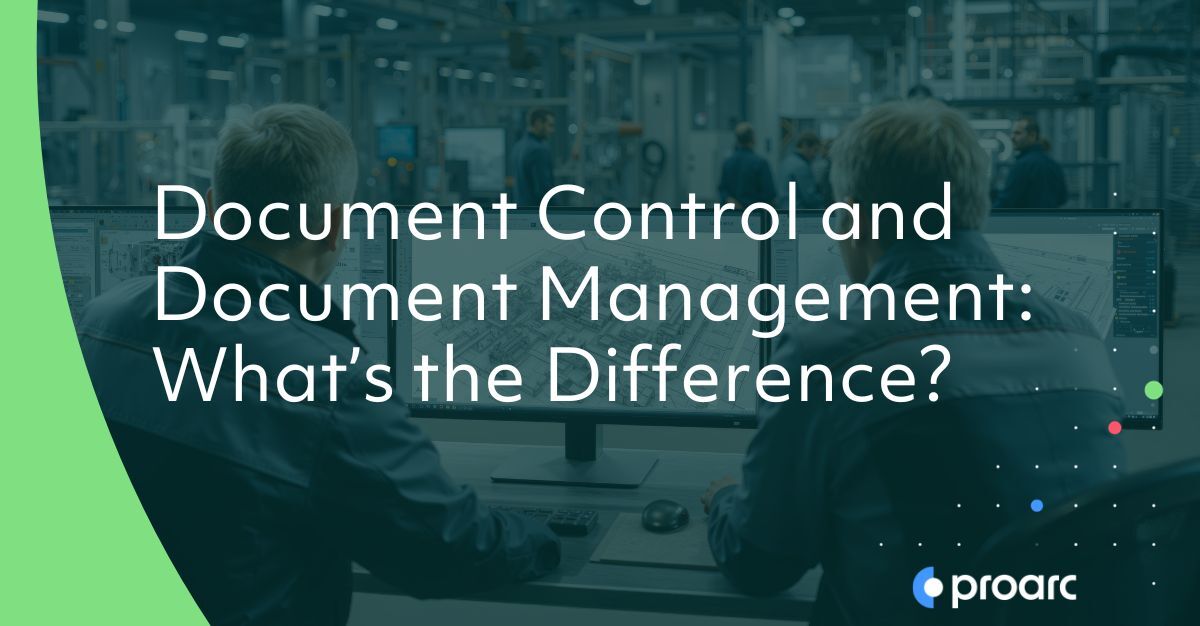
Document Control 101
What is Document Control?
At a high level, document control is the discipline of managing the creation, review, distribution, and storage of project-related documents in a structured, accountable manner. In large-scale projects, document control is a critical discipline that ensures the right information reaches the right people at the right time.
“Documents, often in the form of engineering documents, and information related to documents are essential components to successfully managing projects from design and construction to managing the asset built during operations."
-'Joel Gray, 'Supporting the 6 Values of Document Control'
Although it may sound straightforward, document control can quickly become overwhelming in large-scale EPC (Engineering, Procurement, and Construction) projects. These projects involve thousands of documents, multiple stakeholders, and strict compliance requirements. Without robust document control practices, teams risk working from outdated or unofficial versions of documents, leading to delays, safety hazards, and costly errors.  Effective document control is integral to the success of large projects. In these settings, document control isn’t just about organisation; it’s about managing the lifecycle of thousands (or even millions) of documents, including engineering drawings, specifications, RFIs, transmittals, and vendor data. Each document may go through multiple revisions, reviews, and approvals, often involving different disciplines and external stakeholders.
Effective document control is integral to the success of large projects. In these settings, document control isn’t just about organisation; it’s about managing the lifecycle of thousands (or even millions) of documents, including engineering drawings, specifications, RFIs, transmittals, and vendor data. Each document may go through multiple revisions, reviews, and approvals, often involving different disciplines and external stakeholders.
The complexity of large projects introduces unique risks. With dozens of contractors, hundreds of suppliers, and multiple internal teams working in parallel, the potential for miscommunication and document-related conflicts increases exponentially. For example, if a structural drawing is revised but not properly distributed to the fabrication team, it can result in costly rework or delays. Similarly, without clear version control, teams may unknowingly rely on outdated specifications, leading to compliance issues or safety hazards. As the volume of documentation grows, maintaining traceability, ensuring regulatory compliance, and keeping the project aligned with schedule milestones becomes increasingly difficult unless supported by a robust, centralised document control system.
Related Content
Why Document Control? (Hint: Risk Mitigation)
Document control is a foundational discipline used to ensure that project documentation is accurate, accessible, and aligned across all stakeholders; from engineering teams to contractors, vendors, and clients.
Document control helps project teams:
- Improve the reliability and traceability of project documentation,
- Strengthen alignment between contributors and reviewers, and
- Streamline workflows to keep projects moving forward efficiently.
Document control achieves this by providing a structured framework for managing documents throughout their lifecycle: creation, review, approval, distribution, changes, and archiving. It eliminates confusion around document versions, ownership, and deadlines, while enabling the collaboration and oversight needed to keep complex projects on track.
Common Challenges for Document Controllers
Document controllers play a vital role in keeping EPC projects organised, compliant, and on schedule. But in practice, they often face a range of challenges that stem from outdated systems, fragmented workflows, and increasing project complexity. The most common are:
Lack of Early-Stage Validation
Traditional systems don’t allow teams to enforce standardised formats or numbering before documents are submitted. As a result, controllers spend significant time chasing corrections after the fact, leading to delays and unnecessary back-and-forth with suppliers.
Limited Visibility into Workloads
Without tools to track task progress or reassign reviews, document controllers struggle to manage capacity and keep workflows moving. This lack of transparency makes it difficult to prioritise tasks or respond to bottlenecks in real time.
Inflexible Client Delivery Requirements
Many systems don’t support issuing documents in varied formats or uploading to individual client portals. This forces teams to rely on manual workarounds, increasing the risk of errors and slowing down delivery.
Disconnection from Project Schedules
Document control is often siloed from broader project planning tools like Primavera P6. Without integration, controllers lack visibility into critical path activities and can’t anticipate documentation needs in advance, making it harder to align document workflows with project milestones.
Document Control Best Practices
Effective document control is essential for keeping EPC projects on track, compliant, and collaborative. While every organisation may tailor its approach to fit specific workflows, several best practices consistently help teams improve accuracy, reduce delays, and streamline communication:
1. Plan Ahead with Document Metadata
Assign document numbers, metadata, and templates before files are submitted. This proactive step ensures suppliers know exactly what’s expected and helps prevent formatting errors or misclassification later in the process.
Proarc allows teams to assign document numbers, metadata, and templates before files are submitted. This proactive setup helps suppliers understand expectations and reduces formatting errors and misclassification.
2. Enforce Validation Rules Early
Use automated validation to reject documents that don’t meet project standards before they enter review workflows. This reduces back-and-forth and ensures only compliant files move forward.
Proarc includes configurable validation rules that automatically reject documents not aligned with project standards. This ensures only compliant files enter workflows.
3. Maintain Visibility and Flexibility
Equip document controllers with tools to track workloads, reassign tasks, and manage capacity. Full visibility into review status helps teams avoid bottlenecks and keep deliverables moving.
In Proarc, document controllers have access to dashboards, group inboxes, and activity lists to monitor workloads, reassign tasks, and manage capacity effectively.
4. Support Structured Collaboration
Enable secure, multi-stakeholder collaboration through platforms that support markup, co-editing, and structured document exchange. This ensures feedback is consolidated and traceable.
Proarc enables secure, multi-stakeholder collaboration through features like Microsoft 365 co-editing, ProView markup, and the Proarc Collaboration Room.
5. Automate Repetitive Tasks
Use bulk import, mass updates, and automated transmittals to reduce manual effort. Automation not only saves time but also improves consistency and reduces the risk of human error.
Proarc offers bulk import, mass updates, document copying, and automated transmittals to reduce manual effort and improve consistency.
6. Standardise Across Projects
Establish consistent templates, numbering schemes, and SDRLs (Supplier Document Requirements Lists) across projects. Standardisation improves quality control and simplifies onboarding for suppliers and contractors.
Proarc supports consistent templates, numbering schemes, and SDRLs across projects. These can be pre-configured to ensure suppliers submit documents correctly from the outset.
Document Control Benefits
Version Control
When hundreds of people are working across disciplines, version confusion can be costly. Document control ensures everyone is working from the latest approved version, with full revision history available for audits, reviews, and compliance checks. Whether it’s a piping layout or a vendor datasheet, version integrity matters.
Compliance & Governance
Large projects often span multiple jurisdictions, standards, and contractual obligations. Document control helps teams meet regulatory and client-specific requirements by maintaining traceability and ensuring that documentation is complete, approved, and properly archived.
Information Accessibility
Delays often stem from missing or outdated information. Document control systems make sure the right people have access to the right documents; whether it’s a QA inspector needing the latest welding spec or a subcontractor looking for installation drawings. Timely access keeps work moving.
Risk Mitigation
Using the wrong drawing or spec can lead to rework, safety issues, or even contractual disputes. Document control reduces these risks by enforcing validation rules, protecting sensitive data, and ensuring that only approved documents enter the workflow.
Workflow & Approval Management
Clear ownership and structured workflows help teams stay accountable. Document control systems track who’s reviewing what, when it’s due, and whether it’s been approved; complete with timestamps and audit trails. This is especially important when managing deliverables across multiple contractors.
Integration Access Stakeholders
Large projects involve a web of contributors: EPCs, vendors, clients, and regulators. Document control helps standardise formats, naming conventions, and submission protocols; making collaboration smoother and reducing friction between parties.
"To complete a successful project, the most important requirements are documentation, documentation, and documentation.
-Michael G. Petko (Project Management Institute)
Related Content
Document Control Software
If you're ready to improve information quality, reduce rework, ensure compliance, ensure projects stay on track and on schedule, and keep your project documentation aligned across teams and systems, then it's time to implement a formal document control solution—like Proarc Engineering Document Control Software.
Projects across heavy industries have trusted Proarc for decades to manage complex documentation workflows. Proarc equips you with the tools and support you need to:
- Improve information quality and accessibility
- Ensure compliance with internal policies and industry standards
- Reduce errors and minimise costly rework
- Enhance team performance and collaboration
- Identify and mitigate documentation-related risks
- Reduce claims and disputes through better traceability
For a closer look at how Proarc supports document control excellence, visit the Proarc Document Control Software page or request a tailored demo.
Core Components of Document Control Software
Document control software provides the structure and tools needed to manage engineering documentation efficiently across the entire project lifecycle. Proarc includes the core components of efficient document control, which have been designed to improve information quality, reduce risk, and enhance team performance.
Here are the essential components you should expect from a modern document control system like Proarc:
1. Document Workflow & Transmittal Management
At the heart of Proarc is its ability to manage document workflows with precision and consistency. The system supports configurable workflows that guide documents through creation, review, approval, and distribution. For outgoing documentation, Proarc includes full support for outbound transmittals, enabling teams to collect, organise, validate, and distribute document packages efficiently. It also automates the generation of transmittal cover sheets and PDF comment sheets, ensuring that every outgoing package is complete, traceable, and professionally formatted.
2. Bulk Processing & Automation
Large projects generate massive volumes of documentation, and Proarc is designed to handle that scale. Its bulk import and export capabilities allow teams to move files and metadata in and out of the system using flexible layout definitions. Revision-level attributes can be applied automatically, and watched folders can be configured to trigger scheduled imports, reducing the need for manual intervention.
Proarc also supports bulk copy and paste of document numbers between search results and workflow lists, making it easier to manage large sets of documents in one go. For external sharing, the mass export feature allows users to generate complete document packages—including all related files and metadata—with a single click.
3. PDF Conversion & Output Management
Proarc includes built-in tools for converting and merging files into PDFs from multiple formats. These conversions can be triggered automatically based on configurable rules, ensuring that documents are consistently formatted and ready for review or distribution. This is especially useful for standardising deliverables across diverse contributors and ensuring compatibility with client requirements.
4. Advanced Search & Metadata Management
Proarc supports advanced search queries that allow users to build complex filters using operators, parameters, and nested groupings. This makes it easy to generate precise document lists based on specific criteria. The system also includes detachable document profiles, which simplify the comparison of metadata across revisions or document sets. Users can drag and drop files between profiles, making updates and organisation more intuitive and efficient.
5. Handover & Closeout Support
Proarc supports the full lifecycle of documentation, including project closeout. Its handover tools allow teams to compile, format, and publish structured information packages for clients. These packages can be delivered as offline web-based document catalogues, complete with categorisation and a table of contents, ensuring that handover is not only compliant but also easy to navigate.
6. Security & Access Control
To protect sensitive project information, Proarc includes robust role-based access controls. These permissions ensure that only authorised users can view, edit, or approve documents, supporting both internal governance and external collaboration.
Digital Transformation with Document Control
Digital transformation is the strategic adoption of digital technologies to improve processes, enhance collaboration, and unlock new efficiencies across an organisation. In major projects, such as EPC projects, it means moving beyond manual workflows and disconnected systems to create smarter, more integrated ways of working. 
Document control plays a central role in this transformation. It shifts teams away from reactive, manual processes like spreadsheets and filing toward proactive, data-driven management of project documentation. By digitising workflows, enforcing standards, and improving visibility, document control becomes more than an administrative function, but a driver of project performance, compliance, and collaboration.
Proarc Engineering Document Management Software is designed to lead this shift. Unlike traditional systems that sort files on arrival, Proarc enables teams to plan ahead. Document numbers and metadata are assigned before submission, so suppliers know exactly what’s expected; reducing confusion and improving quality from the start.
Reimagining Document Control with Proarc
In major EPC projects, document control is no longer just about managing files, but enabling precision, collaboration, and speed across the entire project lifecycle. Traditional document control systems often wait for files to arrive, then scramble to sort, validate, and distribute them.
Proarc flips this model by enabling teams to work proactively and automate key tasks:

1. Organise
Start with structure. Pre-allocate document profiles and numbers before creation. Link documents to packages for clear planning and tracking so suppliers know what’s expected from day one.
2. Plan
Integrate document workflows with project schedules using tools like Primavera P6. This ensures alignment with the critical path and avoids delays.
3. Execute
Automate validation with rule-based checks that reject non-compliant documents instantly, saving time and reducing rework.
4. Collaborate
Enable proactive collaboration. Document controllers can reassign reviews, manage capacity, and maintain visibility across teams.
5. Track
Monitor progress with full transparency. Stay ahead of bottlenecks and ensure timely reviews and approvals.
6. Deliver
Ensure accurate, compliant, and timely document handover—ready for operations and future modifications.
Operations Cycle
Proarc supports ongoing operations through a continuous cycle of:
Asset Management
Maintain a complete, compliant document record for every asset.
Modifications
Track changes and ensure updated documentation flows seamlessly into operations.
Maintenance
Keep documentation aligned with maintenance activities to support safety, compliance, and efficiency.
Document Control FAQs
1. What are the long-term benefits of investing in document control software?
Implementing document control software improves project predictability, reduces delays and disputes, and ensures compliance with standards. Over time, it enhances team performance, supports audit readiness, and transforms document control from a reactive task into a strategic asset for project delivery.
2. Why do manual document control systems often fall short?
Traditional systems rely heavily on manual processes and decentralised tools like spreadsheets, email chains, and physical filing. They typically lack early-stage validation, integration with project schedules, and flexibility for client-specific delivery formats. This leads to delays, errors, and increased administrative burden.
3. How does Proarc improve document control processes?
Proarc enables proactive planning by allowing teams to pre-allocate document numbers and metadata before submission. In addition, Proarc enforces validation rules and integrates with tools like Primavera P6 to streamline data. These features help improve document control efficiencies and reduce errors.




